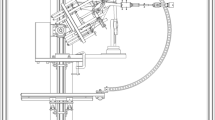Abstract
Previous studies demonstrate that scapulohumeral mechanics improve after subacromial injection. However, it is unclear how injection affects muscle firing. Forty-one subjects with two-tendon rotator cuff tears and 23 volunteer subjects with normal rotator cuffs documented by ultrasonography were examined. Electromyographic activity from 12 muscles was collected during ten functional tasks. Nine symptomatic subjects with rotator cuff tears underwent subacromial injection of anesthetic and underwent repeat electromyographic examination. Subjects with rotator cuff tears demonstrate global electromyographic differences when compared to normal controls. Asymptomatic subjects with rotator cuff tears had significantly increased anterior deltoid firing when compared to symptomatic counterparts during forward shoulder elevation. After subacromial injection, symptomatic subjects demonstrate increased anterior deltoid firing. Previous in vitro and in vivo studies have suggested that pain leads to deltoid inhibition and that subacromial injection leads to improved deltoid firing and, subsequently, improved shoulder function. This study provides direct evidence that subacromial injection improves deltoid firing in symptomatic subjects with rotator cuff tears. These findings reinforce the concept that deltoid inhibition resulting from pain is an important component of the motor disability associated with rotator cuff tears.



Similar content being viewed by others
References
Altchek DW, Warren RF, Wickiewicz TL, Skyhar MJ, Ortiz G, Schwartz E (1990) Arthroscopic acromioplasty: Technique and results. J. Bone Jt. Surg. Am. 72:1198–1207
Anderson K, Boothby M, Aschenbrener D, van Holsbeeck M (2006) Outcome and structural integrity after arthroscopic rotator cuff repair using 2 rows of fixation: Minimum 2 year follow-up. Am. J. Sports Med. 34:1899–1905
Cordasco FA, Backer M, Craig EV, Klein D, Warren RF (2002) The partial-thickness rotator cuff tear: is acromioplasty without repair sufficient? Am. J. Sports Med. 30(2):257–60
Galatz LM, Ball CM, Teefey SA, Middleton WD, Yamaguchi K (2004) The outcome and integrity of completely arthroscopically repaired large and massive rotator cuff tears. J. Bone Jt. Surg. 86A:219–224
Hansen ML, Otis JC, Johnson JS, Cordasco FA, Craig EV, Warren RF (2008) Biomechanics of massive rotator cuff tears: Implications for treatment. J. Bone Jt. Surg. Am. 90:316–25
Kedgley AE, Mackenzie GA, Ferreira LM, Johnson JA, Faber KJ (2007) In vitro kinematics of the shoulder following rotator cuff injury. Clin. Biomech. 22:1068–73
Kelly BT, Williams RJ, Cordasco FA, Backus SI, Otis JC, Weiland DE et al (2005) Differential patterns of muscle activation in patients with symptomatic and asymptomatic rotator cuff tears. J. Shoulder Elbow Surg. 14:165–171
L’Insalata JC, Warren RF, Cohen SB, Altchek DW, Peterson MG (1997) A self-administered questionnaire for assessment of symptoms and function of the shoulder. J. Bone Jt. Surg. 79A:738–48
Lippett S, Harryman DT, Matsen FA (1993) A practical tool for evaluating function: The simple shoulder test. In: Matsen FA, Fu FH, Hawkins R (eds) The Shoulder: A Balance of Mobility and Stability. Park Ridge, Chicago, pp 501–18
Reddy AS, Mohr KJ, Pink MM, Jobe FW (2000) Electromyographic analysis of the deltoid and rotator cuff muscles in persons with subacromial impingement. J. Shoulder Elbow Surg. 9:519–23
Richards RR, An KN, Bigliani L, Friedman RJ, Gartsman GM, Gristina AG et al (1994) A standardized method for the assessment of shoulder function. J. Shoulder Elbow Surg. 3:347–52
Scibek JS, Mell AG, Downie BK, Carpenter JE, Hughes RE (2008) Shoulder kinematics in patients with full thickness rotator cuff tears after a subacromial injection. J. Shoulder Elbow Surg. 17:172–81
Snyder SJ, Pachelli AF, Del Pizzo W, Friedman MJ, Ferkel RD, Pattee G (1991) Partial thickness rotator cuff tears: Results of arthroscopic treatment. Arthroscopy 7:1–7
Thompson WO, Debski RE, Boardman ND 3rd, Taskiran E, Warner JJ, Fu FH et al (1996) A biomechanical analysis of rotator cuff deficiency in a cadaveric model. Am. J. Sports Med. 24:286–92
Acknowledgments
The authors gratefully acknowledge the assistance of Mark W. Lenhoff and Brian S. Pansy for data analysis; Ronald S. Adler MD for musculoskeletal imaging and interpretation; David W. Altchek MD, Russell F. Warren MD, Edward V. Craig MD, and Thomas L. Wickiewicz MD for their suggestions for study improvement and patient contributions; Daniel E. Weiland MD and Samuel P. Robinson MD for early project development and patient recruitment; and previous sports fellows Eric L. Chehab MD, Aimee S. Klapach MD, William M. Isbell MD, Daniel P. Tomlinson MD, and Nikhil N. Verma MD for their involvement in patient recruitment.
Author information
Authors and Affiliations
Corresponding author
Additional information
Each author certifies that he or she has no commercial associations (e.g., consultancies, stock ownership, equity interest, patent/licensing arrangements, etc.) that might pose a conflict of interest in connection with the submitted article.
Each author certifies that his or her institution has approved the reporting of these cases, that all investigations were conducted in conformity with ethical principles of research, and that informed consent for participating in the study was obtained.
This study was performed at Leon Root, M.D. Motion Analysis Laboratory, Hospital for Special Surgery, 510 East 73rd Street, New York, NY 10021, USA.
Rights and permissions
About this article
Cite this article
Cordasco, F.A., Chen, N.C., Backus, S.I. et al. Subacromial Injection Improves Deltoid Firing in Subjects with Large Rotator Cuff Tears. HSS Jrnl 6, 30–36 (2010). https://doi.org/10.1007/s11420-009-9127-6
Received:
Accepted:
Published:
Issue Date:
DOI: https://doi.org/10.1007/s11420-009-9127-6




